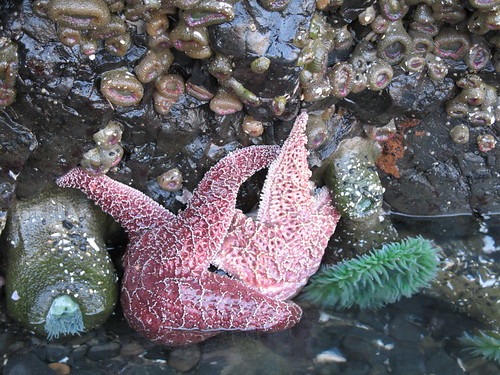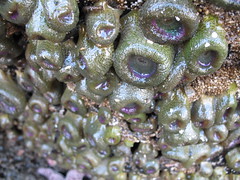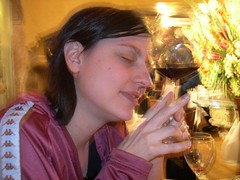Back Home, remembering Moab
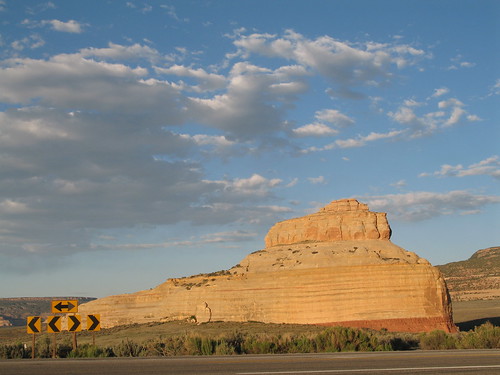
What is it, like, a month since I've been home from my trip? And still I haven't posted about one of my most favorite stops on the road. Sheesh!
My life is like that. I hop off of one thing, sometimes a hair too soon, and I'm ready to get cracking on another. Of course, the current 'another' is finding a job and settling down into my house. Not quite as alluring as a road trip, unless you've been on one for three months.
I had a choice while back up in Washington state of routes through Utah. One would have taken me to the Northern rim of the Grand Canyon, and for a while that was the plan. Then a friend called and told me she'd be in southern Colorado, and would I be into meeting up in Taos, NM. I said hell yeah, and so my new route would take me through Moab. Oh well, I thought, I'm sure it's pretty there, too.
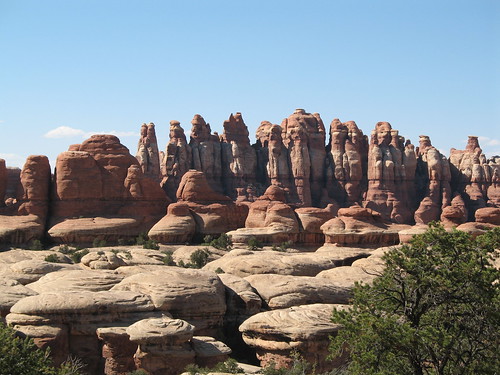
Oh my God. Am I on Mars? This one's from Canyonlands National Park, a vast landscape of sandstone sculptures, winding riverbeds, buttes and canyons. I went on a six-mile hike in the Needles District on fine day, and it was amazing. Except for those kids...there was this young couple of yups and their two wild boys just ahead of me who all felt that the 'Stay on the Trail' did not apply to children, who were free to stomp up the delicate plant life to their heart's content. Little fuckers.
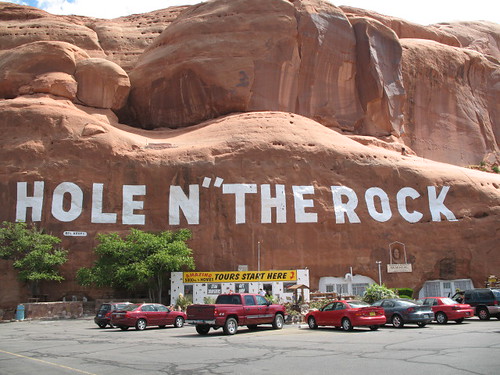
Now you know how I love my roadside attractions. Just about forty-five minutes south of Moab is Hole 'N The Rock, which delivered all the things I crave: a great story, endless kitsch, and emus. Albert and Gladys Christensen called this 5,000 square foot excavated sandstone home, and both were buried in a little grotto just outside of it (check out the website for photos of the inside.)
Ah, Albert was such a multitalented man: Frankenstein like taxidermy, oil paintings of FDR, Indians and Our Lord, and...well, blowing giant holes in rock. His wife favored beadery and doll collections. The two of them lived inside the rock and ran a cafe in front of the living quarters during the uranium boom. He was working on an elevator shaft that would access a desert rock garden at the top of the rock when he died in 1957.
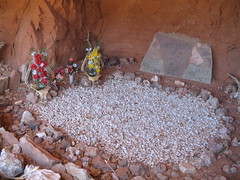 Gladys stayed in the house until her death in '74 and even fashioned herself a rock bathtub. It has since changed hands a couple of times and now belongs to a family from SLC whose youngest son---I'm guessing 13---was the consummate tour guide. Onsite emus will give you dirty looks for free. Don't pass it up if you're ever out there.
Gladys stayed in the house until her death in '74 and even fashioned herself a rock bathtub. It has since changed hands a couple of times and now belongs to a family from SLC whose youngest son---I'm guessing 13---was the consummate tour guide. Onsite emus will give you dirty looks for free. Don't pass it up if you're ever out there.
Arches National Park is just a hair north of Moab, and was the inspiration for all those Road Runner cartoons. The most famous formation, Delicate Arch, is the shamelessly ubiquitous image on every liscense plate, body shop sign and plastic cup in the city. I was determined to see it right at sunset, when everyone scrambles up a half mile of slickrock to see the play of deep orange light on the sandrock. I was so busy with my dinner at Buck's Grill House (which I recommend) that I lost track of the time and had to haul ass and still missed the Golden Moment. I sat in the waning light and watched an old man walk around the base of this gorgeous formation, and It Was Good.
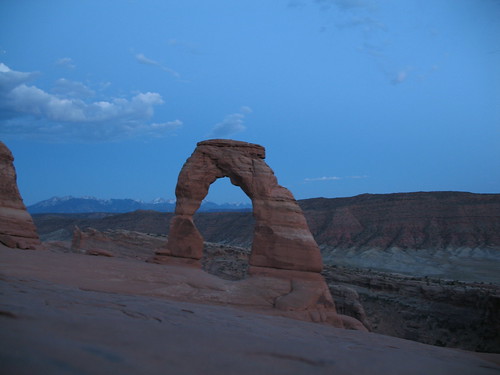
Oh, man, what else? There was horseback riding and rafting and the German woman who took off her pants. A few of the local servers were surly, and for the love of God, do NOT eat at the Slickrock Cafe. The service will make you feel like killing someone.
T.
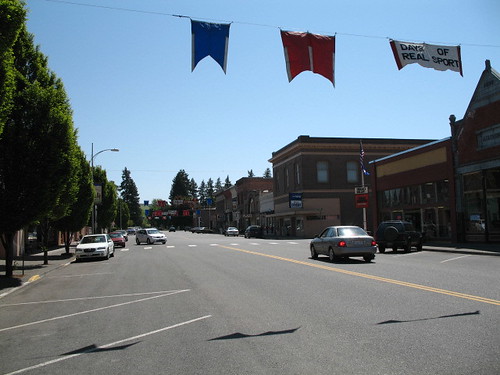
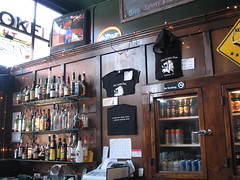 Ah-hah. There's something. It looks like a cool dive bar. Sure 'nuff, you've found the
Ah-hah. There's something. It looks like a cool dive bar. Sure 'nuff, you've found the 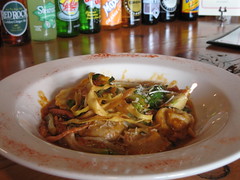 Excellent work, people.
Excellent work, people.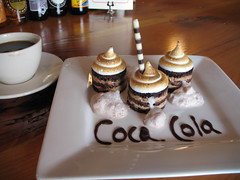 Damn, that's good.
Damn, that's good.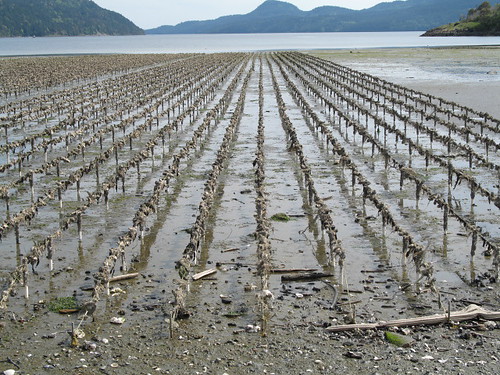 I couldn't have told you how oysters were farmed, either, until I went to Orcas Island. Yeah, water's obviously involved--the average oyster filters fifty gallons of it through its body a day--but beyond that, I had no idea.
I couldn't have told you how oysters were farmed, either, until I went to Orcas Island. Yeah, water's obviously involved--the average oyster filters fifty gallons of it through its body a day--but beyond that, I had no idea.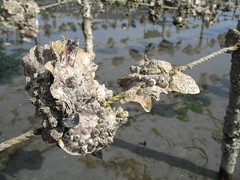 I'm all questions at this point: how many oysters are in that mess? How long do they take to grow? Do I get in a lot of trouble if I eat one?
I'm all questions at this point: how many oysters are in that mess? How long do they take to grow? Do I get in a lot of trouble if I eat one?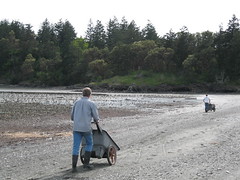 Bill and Elijah rolled gray wheelbarrows out to a lot of rows. Harvesting is done by sawing the oyster-heavy ropes off the pvc that holds them, and is done to-order rather than all at once. Bill names off the amount each restaurant has requested, including the Inn at Ship Bay, which has ordered several dozen. It's an approximate business, since it's difficult to tell exactly how many of the little guys are hiding in one big chunk. After they're harvested, they go to a separate processing plant to be separated, de-barnacled and sorted for delivery.
Bill and Elijah rolled gray wheelbarrows out to a lot of rows. Harvesting is done by sawing the oyster-heavy ropes off the pvc that holds them, and is done to-order rather than all at once. Bill names off the amount each restaurant has requested, including the Inn at Ship Bay, which has ordered several dozen. It's an approximate business, since it's difficult to tell exactly how many of the little guys are hiding in one big chunk. After they're harvested, they go to a separate processing plant to be separated, de-barnacled and sorted for delivery.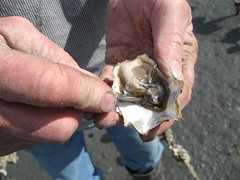 Bill explains the price tag: these crustaceans are raised the old fashioned way, seeded on a 'mother shell' attached to the rope, rather than in mesh bags. The oysters that grow on the bottom of the clump have much thinner shells, and therefore spend more time growing their own bodies rather than worrying too much about protection. It takes around three years for the oysters to reach maturity, so seeding and harvesting are in constant cycle.
Bill explains the price tag: these crustaceans are raised the old fashioned way, seeded on a 'mother shell' attached to the rope, rather than in mesh bags. The oysters that grow on the bottom of the clump have much thinner shells, and therefore spend more time growing their own bodies rather than worrying too much about protection. It takes around three years for the oysters to reach maturity, so seeding and harvesting are in constant cycle.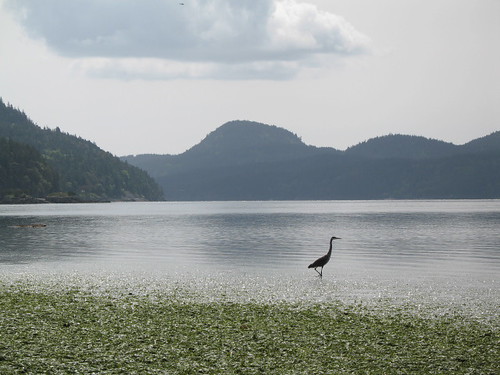 If you follow both this blog and
If you follow both this blog and 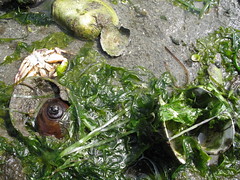 For a local, the beach and its inhabitants might have already blended into the mundane, but not for me. I'm feeling like a wee tot on her first visit to the ocean, and I stop to inspect anything that moves, has color, or glints in the sunlight. There are dead crabs to turn over, more giddily fascinating purple starfish, and great big oyster shells laying open like expensive glass ashtrays, all usually hidden under the tide.
For a local, the beach and its inhabitants might have already blended into the mundane, but not for me. I'm feeling like a wee tot on her first visit to the ocean, and I stop to inspect anything that moves, has color, or glints in the sunlight. There are dead crabs to turn over, more giddily fascinating purple starfish, and great big oyster shells laying open like expensive glass ashtrays, all usually hidden under the tide.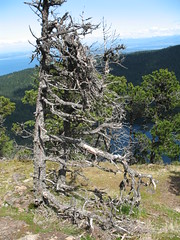 Redwoods are beautiful, and I've hiked through a lot of them on this trip, but there's something about the Washington pines that I love even better. The color palate of this forest is cooler, and I dig the soft, bright green fuzz of skinny saplings. It seems quieter, more remote. Luke tells me there are very few beasties that live in this area; no predators or badgers or snakes, but a few deer and scads of tiny birds. But even these are elusive, and the thickest part of the forest is uncannily still.
Redwoods are beautiful, and I've hiked through a lot of them on this trip, but there's something about the Washington pines that I love even better. The color palate of this forest is cooler, and I dig the soft, bright green fuzz of skinny saplings. It seems quieter, more remote. Luke tells me there are very few beasties that live in this area; no predators or badgers or snakes, but a few deer and scads of tiny birds. But even these are elusive, and the thickest part of the forest is uncannily still.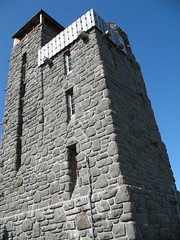 At the summit there's a stone tower, built as part of the New Deal/WPA as an observation deck. Closed for intense remodeling recently, it was open for us. I did my usual lazy thing where I skip the obligatory informational displays about Mr Moran and his legacy and blah blah blah and ran right up to the top. You can see all the islands, the shorelines, the Cascade and Olympic Mountains. On a more clear day, you can see Vancouver and Seattle.
At the summit there's a stone tower, built as part of the New Deal/WPA as an observation deck. Closed for intense remodeling recently, it was open for us. I did my usual lazy thing where I skip the obligatory informational displays about Mr Moran and his legacy and blah blah blah and ran right up to the top. You can see all the islands, the shorelines, the Cascade and Olympic Mountains. On a more clear day, you can see Vancouver and Seattle.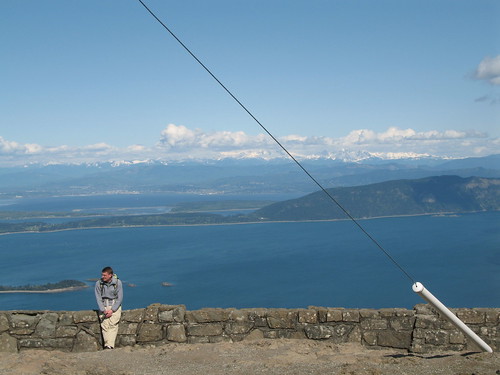
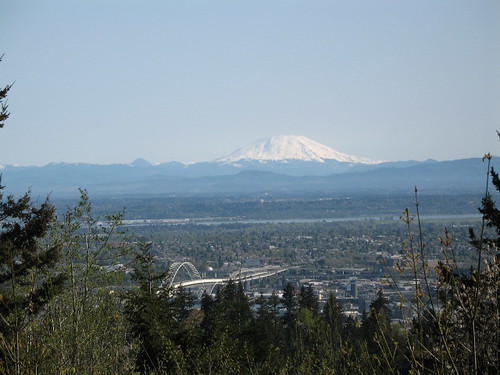 Before moving to Portland, B. Deckert got pickled one night and extolled the virtues (read: went on and on) of the city: it was beautiful, it was clean, well placed within an hour's drive either way of stunning scenery, it was tolerant and friendly and intelligent and little faeries of happiness washed your ass for you every single day.
Before moving to Portland, B. Deckert got pickled one night and extolled the virtues (read: went on and on) of the city: it was beautiful, it was clean, well placed within an hour's drive either way of stunning scenery, it was tolerant and friendly and intelligent and little faeries of happiness washed your ass for you every single day.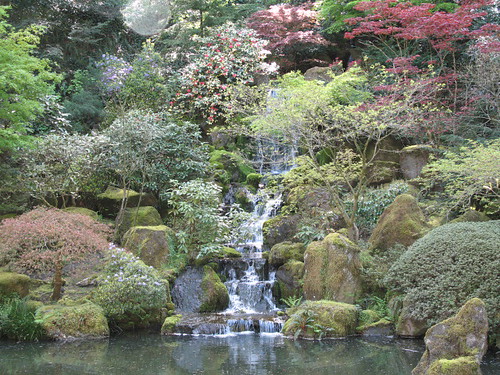 The Japanese Garden is one of the most beautiful I've ever seen. Apart from the groundskeeper, a loud guy who looked like he just stepped out of a Kurosawa movie barking at a little kid for running on the grass, it was quite serene. A bit lacking in the koi department, however, which is a drag.
The Japanese Garden is one of the most beautiful I've ever seen. Apart from the groundskeeper, a loud guy who looked like he just stepped out of a Kurosawa movie barking at a little kid for running on the grass, it was quite serene. A bit lacking in the koi department, however, which is a drag.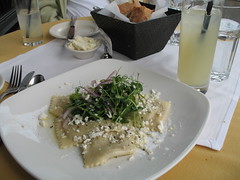
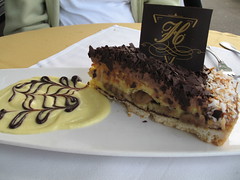 bitch about eating pie in Portland on a sunny afternoon.
bitch about eating pie in Portland on a sunny afternoon.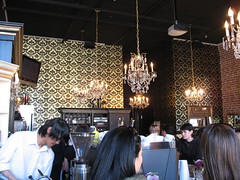 Now Mother's Bistro's a fun joint, except for the intimidating wait. I had a simple lox bagel for brunch, but it was done as good as one could ask, and went one better by letting me put it together myself. See, I like the capers underneath the salmon, so they stick in the cream cheese and don't roll off.
Now Mother's Bistro's a fun joint, except for the intimidating wait. I had a simple lox bagel for brunch, but it was done as good as one could ask, and went one better by letting me put it together myself. See, I like the capers underneath the salmon, so they stick in the cream cheese and don't roll off. 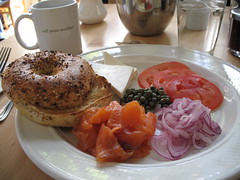 Kudos to Mother's for saving me the trouble of disassembly. I visited later on for a Mexican chopped salad. To the manager, I said, "This reminds me exactly of a salad my mom made when I was a kid." And of course, that's the idea.
Kudos to Mother's for saving me the trouble of disassembly. I visited later on for a Mexican chopped salad. To the manager, I said, "This reminds me exactly of a salad my mom made when I was a kid." And of course, that's the idea.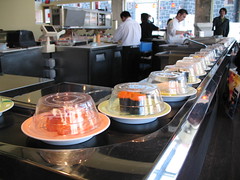 Hooray for conveyor belt sushi! It's cheap, it's halfway decent (except for the canned corn roll...wtf???) and if you have no one to talk to, you can zone out on the gentle whir and clink of passing plastic plates.
Hooray for conveyor belt sushi! It's cheap, it's halfway decent (except for the canned corn roll...wtf???) and if you have no one to talk to, you can zone out on the gentle whir and clink of passing plastic plates.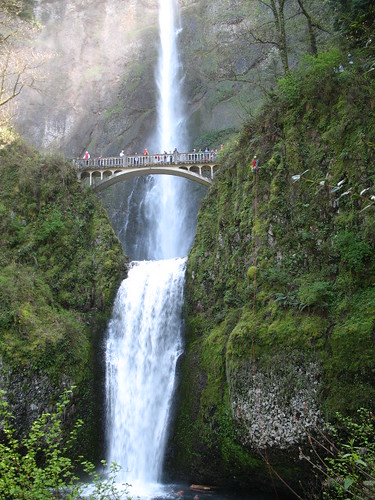
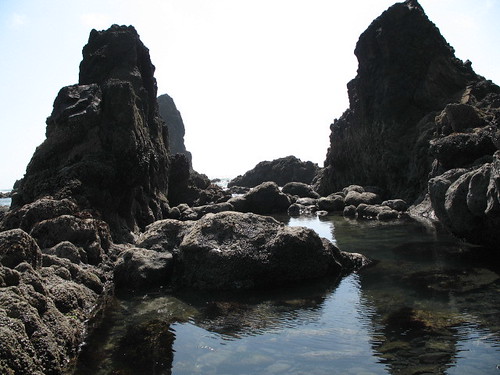
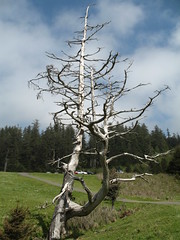 Except for the requisite Pacific chill, the weather is flawless. Only the slight fogginess keeps distant objects from clear sight. Just beyond the parking lot and before you get to the vistas, there's a grassy picnic area dotted with teeny daisy-like flowers, as if spring could get any lovlier here.
Except for the requisite Pacific chill, the weather is flawless. Only the slight fogginess keeps distant objects from clear sight. Just beyond the parking lot and before you get to the vistas, there's a grassy picnic area dotted with teeny daisy-like flowers, as if spring could get any lovlier here.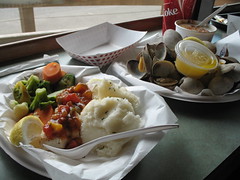 it was even better the second time.
it was even better the second time.